Making cycling irresistable in DC
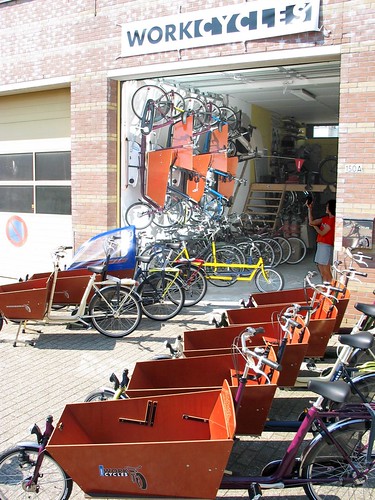
Workcycles store, Amsterdam. Photo: Henry Cutler.
I'm working on something oriented to taking DC to the next level in the accommodation and encouragement of bicycling, and then beyond that to a world class level. There's a document I've circulated to some people (based on a review of the DC Bicycle Master Plan, Professor Pucher's journal article, and many other documents and plans from other U.S. cities and London). Henry Cutler, proprietor of Workcycles in Amsterdam, responded thusly:
The first thing that struck me as "getting it" is your clarification of a philosophy that cycling etc are part of normal daily activities, of course as opposed to recreation, but in this case also as opposed to "commuting."
Somehow, perhaps because of the city layouts and the workaholic nature of americans, most "practical" cycling seems to get interpreted as "commuting," ignoring all of the other transportation accomplished with bicycles: bringing the kids to school, shopping, going to a restaurant/cafe/friend's house... which tend to be combined as timing and routes allow. Of course there are also the commercial uses: delivering mail/pizza, riding to a meeting etc.
This tunnel vision seems to get many cycling discussions focused on things that probably will have little impact on promoting cycling: showers in office buildings for example - if it requires that much sweat only the hardcore will ever cycle to work, and they'll do it with or without showers.
You mention this later and it would seem to me that commuting to and from the city can never expand to beyond the hardcore cyclists and have a meaningful impact. That's what public transport is for. Look at Amsterdam where most people cycle daily. Almost nobody cycles to work from outside the city and the distances are very small here.
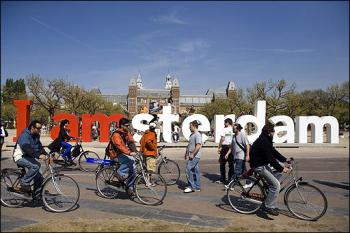
AFP photo.
If you have cycling use data that's skewed toward young men, it will underrepresent all of the things women do on bikes: carry kids around, shop, do social things and their interests: being comfortable and not messing up nice clothes is far more important for women. Multipurpose cycling trips are much more common amongst women: drop baby off at nursery, drop older child off at kindergarten, go to work. Reverse trip includes shopping and browsing for a new skirt along the way.
I had to giggle when I saw the bike racks at Friends National Service Comittee. 8 bikes? You could fit parking for 20 or more bikes there. The rule of thumb here seems to be 10 bike parking places per (euro sized) car parking spot.
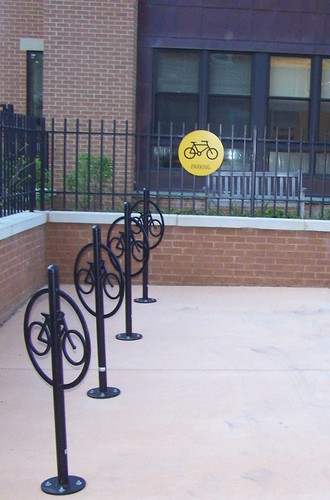
Bicycle parking at the Friends building, cropped (2nd & C Streets NE)
Concerning bike racks most of the more elaborate designs tend to be unhandy, especially if they include facilities for locking bikes. They don't seem to fit many bikes. Racks that hold bikes by the front wheel are regarded here as bike destroyers. Instead most people favor what they call "staples," much like the simple hoops in the background of your second photo.
Concerning the development of bike shops/WorkCycles in DC, I'd point out that it's not so much that more bike shops needed, but more specifically shops oriented toward the practical cyclist as found in the Netherlands and Denmark: city bikes, child seats, carriers, lights, special carrier bicycles etc.
You might not realize that even WorkCycles (which specializes in the heavier duty segments) sells 75% of our bikes to families and individuals: tough, practical city bikes, multiple child transporters etc. The commercial market is growing and what we're best known for but actually not the daily bread and butter.
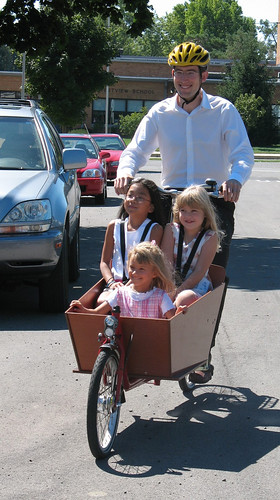
Richmond Indiana Flickr photo by Mark Stosberg
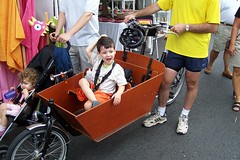
Workcycle in Del Ray, Alexandria (photographer: anonymous).
Labels: bicycling, transportation planning



0 Comments:
Post a Comment
<< Home